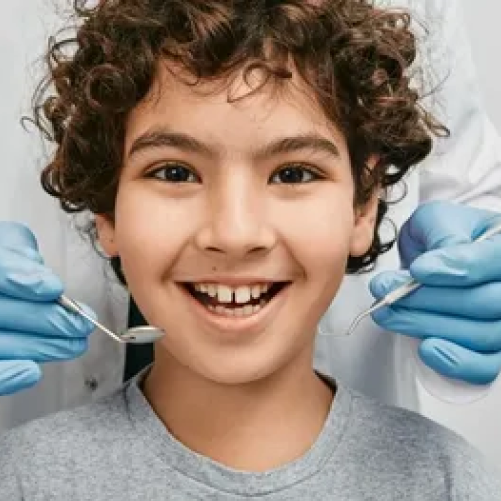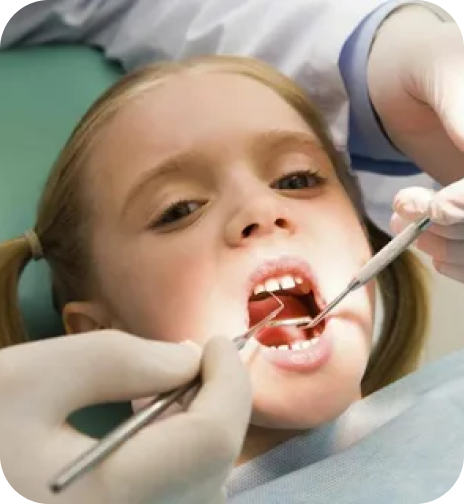Tooth Discoloration
While you may not think that your children’s discolored teeth are anything to worry about while they’re young, tooth discoloration in children may be a sign of a more serious complication, such as an infection. Instead of guessing or waiting until your kids exhibit symptoms, visit Tiny Smiles Pediatric Dentistry — in Woodbridge, New Jersey, Harlem, NY or the Lower East Side, Manhattan — for a definitive diagnosis.

Is it Normal for My Child to Have Discolored Teeth?
Tooth discoloration in children is fairly common. And many correctional options are available, depending on the source of the stains. Teeth may simply fade from bright white to off-white over time. However, if you notice a sudden drastic change in your child’s teeth, or in one tooth in particular, you need to seek a recommendation from your child’s dentist because the change in color may be a symptom of a more serious illness or unknown damage to the gum and root of the tooth.
At Tiny Smiles Pediatric Dentistry, the experienced team of dedicated children’s dentists sometimes can tell just with a visual inspection whether your child needs further dental intervention. They monitor the tooth’s development, especially if it’s accompanied by any pain or discomfort, and continue with regular preventative treatments to ensure your kids maintain a healthy smile.
Diet. Food and drinks that contain a lot of sugar, acid or dyes wears away at teeth, leaving them vulnerable to discoloration.
Injury. A fall or a blow to the mouth could lead to a broken tooth. If the tooth is broken, the root can become infected, leading to a slight browning of the normally white tooth.
Excessive or insufficient fluoride. An overdose of fluoride can damage the natural enamel of the tooth, while a lack of sufficient fluoride may result in cavities and browning.
Weak enamel. Teeth are more susceptible to staining when the outer layer of protective enamel is weakened. Enamel can be damaged by overly acidic or sugary foods. Weak enamel may also be genetic.
Illness. Metabolic diseases, calcium deficiencies, digestive disruptions, and other internal maladies may lead to browning or yellowing teeth.

How Is Tooth Discoloration in Children Treated?
Treatment depends on the source of the discoloration. If, for example the tooth is infected beyond external repair, an extraction may be necessary. Correcting the tooth without removing it is also possible. Tiny Smiles Pediatric Dentistry offers fluoride varnish treatments and teeth whitening for children to restore your child’s smile to its natural bright white color.
Whitening toothpastes and mouthwashes can be useful to maintain the white color over time, but consult your dentist about what’s safest for your child. Other solutions include:
Routine and thorough cleaning can clear up plaque build-up that may be causing the tooth discoloration.
Baking soda and lemon can be used to whiten the teeth at home. The acidic/abrasive combo eats away at the stain. Consult your dentist before using this method to avoid damaging healthy enamel.
Aesthetic treatments like professional whitening are available for children. Microabrasion with bleach is also an option for children if regular brushing and whitening products haven’t solved the problem.
If the discoloration is a symptom of a larger underlying illness, medication to treat said illness may help the issue correct itself over time.
Why Are My Child’s Adult Teeth Coming in Brown?
Dental sealants protect molars and premolars, the chewing teeth, from erosion, wear and bacterial attack. While getting the sealant may help everyone, dentists have identified certain categories of children as the best candidates. They include:
Dental sealants protect molars and premolars, the chewing teeth, from erosion, wear and bacterial attack. While getting the sealant may help everyone, dentists have identified certain categories of children as the best candidates. They include:
- Children with deep grooves on their back teeth. Deep fissures on your children’s molars and premolars make them prone to cavities. The grooves create a perfect habitat for trapping food particles that attract bacteria, which can erode the back teeth.
- Children with newly erupted back teeth. When your children’s back teeth emerge, it’s time for their first dentist visit. At that time, you may ask your dentist for advice on the suitability of dental sealants.
- Children with a history of dental decay. Dental decay affects the overall health of your children. Teeth sealants help halt the progression of caries and prevent gum damage.
- Children who won’t or can’t brush or floss. Some children have health conditions that make it impossible to maintain perfect dental hygiene. These special needs kids are good candidates for dental sealants.

How Can I Maintain My Child’s White Teeth?
Regular brushing and flossing are crucial to sustaining a healthy white smile. Creating good habits in teeth cleaning when your child is young is a good practice for them to carry into adulthood. Contact Tiny Smiles Pediatric Dentistry to set your child up for a healthy dental future.
Regular visits to the dentist for professional cleaning and check-ups help your dentist identify problems before they get worse, providing you with prevention information that keeps your child’s smile white and happy.

